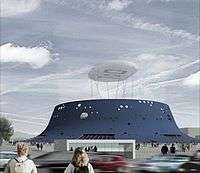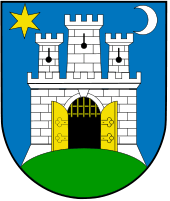Stadion Maksimir
Maksimir Stadium (Croatian: Stadion Maksimir), is a multi-use football stadium based in the Croatian capital, Zagreb. It takes its name from the surrounding neighbourhood of Maksimir. The venue is primarily the home of Dinamo Zagreb, the top club of the country with 20 league titles, but it is also the home venue of the Croatia national football team. First opened in 1912, it has undergone many facelifts, and its current layout dates from a 1997 rebuilding. The stadium also sometimes hosts other events such as rock concerts.
Stadion Maksimir | |
 | |
| Full name | Stadion Maksimir |
|---|---|
| Location | Maksimirska cesta 128, Maksimir, Zagreb, Croatia |
| Coordinates | 45°49′7.89″N 16°1′5.08″E |
| Owner | City of Zagreb |
| Operator | |
| Capacity | 35,123[1] |
| Record attendance | 64,138 (NK Zagreb vs. Osijek, 19 July 1973) |
| Field size | 105 m × 68 m (344 ft × 223 ft) |
| Surface | Hybrid grass |
| Construction | |
| Opened | 5 May 1912 |
| Renovated | 1948, 1998 |
| Tenants | |
| HAŠK (1912–1945) HŠK Građanski (1912–1924) Dinamo Zagreb (1948–present) Croatia national football team (1990–present) NK Lokomotiva (2009–2017) | |
History
The stadium was first opened on 5 May 1912. On 26 May 1941, a representative of the Ustashe fascist government of the Independent State of Croatia addressed young Zagreb students at their meeting at the Maksimir Stadium, and at one point ordered the Serbian and Jewish students to be segregated, but the children disobeyed.[2][3] Soon afterwards, in June 1941, rebel youths burned the stadium down.[3] In 1977, a movie Operation Stadium was made to commemorate the segregation incident.
When the UEFA Euro 1976 final tournament was held in Yugoslavia, Maksimir hosted the Netherlands v. Czechoslovakia semi-final match and the Netherlands v. Yugoslavia third place match.
Maksimir was the central venue for the 1987 Summer Universiade hosted by the city of Zagreb.
In 1990, several events happened at Maksimir. On 13 May, the Dinamo Zagreb–Red Star Belgrade riot took place, an infamous riot involving Dinamo Zagreb and Red Star Belgrade supporters. The last match of the Yugoslavia national football team was hosted at Maksimir on 3 June. On 17 October of the same year, Croatia played the United States in what was Croatia's first match in the modern era.
In 1998, plans were made for a massive renovation, and the first phase started the same year. The old northern stand was demolished and a new one built within a year. This renovation increased Maksimir's seating capacity to 38,079.
After 1992, for 16 years the Croatian football team had a proud unbeaten record at this stadium in any competitive match, however on 10 September 2008 (two years after suffering a 2-0 defeat at the same venue) England became the first team to beat Croatia in Zagreb, winning 4-1, ending a thirty match undefeated streak.
In the summer of 2011, a little, but much needed "facelifting" was made on the stadium. All seats were replaced, a new drainage system, under-soil heating and automatic watering were installed along with a new turf, the athletic track was covered with blue artificial grass and all brick surfaces were covered in blue cloth.
Capacity per sector
Four stands (8 sectors) contribute to the total seating capacity of 35,423:[1]
.jpg)
- North stand (up): 4,510
- North stand (down): 4,950
- North stand (VIP): 300
- West stand (up): 5,101
- West stand (down): 6,369
- West stand (VIP): 748
- East stand: 9,514
- South stand: 3,931
Concerts
The stadium has also been used as the venue for some big concerts, including:
- On 12 July 1983, Dire Straits held a concert to promote their fourth studio album Love Over Gold as a part of band's Alchemy Live Tour (1983).
- On 5 September 1990, David Bowie performed a sold-out concert as a part of his Sound+Vision Tour (1990).
- In 2000, Zlatan Stipišić Gibonni performed a concert in front of 32,000 people, promoting his album Judi, zviri i beštimje (2000).
- On 22 June 2005, Bijelo Dugme performed a reunion concert for a crowd of 70,000 people on their Tour 2005. (2005).
- On 17 June 2007, Marko Perković Thompson performed a concert for a crowd of 70,000 people as a part of his Bilo jednom u Hrvatskoj Tour (2007).
- On 9 and 10 August 2009, U2 performed two sold-out concerts for 124,012 people as a part of their U2 360° Tour (2009-2011).
- On 8 June 2011, Bon Jovi performed a concert for a crowd of 33,698 people as a part of their Bon Jovi Live Tour, which supports the band's sixth compilation album, The Greatest Hits. (2011).
- On 11 June 2012, Madonna was scheduled to perform a concert as a part of her MDNA Tour, but the concert was cancelled due to logistic reasons.
- On 23 May 2013, Depeche Mode was scheduled to perform a concert as a part of their Delta Machine Tour, but the concert was changed to the Arena Zagreb due to logistic reasons.
- On 13 August 2013, Robbie Williams performed a concert in front of 45,000 people, featuring Olly Murs as his opening act, as a part of Take the Crown Stadium Tour (2013).
Renovation plans

According to the 1998 plans, renovation was to include lowering the lawn and making the "ring" round the pitch in the place of running track and thus gain 16,000 new seats with the annex to the south stand with the final addition of a modern roof structure. Maksimir was to have 60,000 comfortable sitting places and was to be an exclusively football stadium like many others in Europe.
It has additionally been planned to build: new premises for Club's Management, Elegant "Blue Lounge", Big "Trophy room", football school premises, changing room, coach staff room, sports hall with gym, out patient clinic, restaurant, luxury hotel ("A" category) with 46 beds for visiting teams special importance will be given to the building which will connect west stand to the north stand. By this, all the conditions for hosting and organizing big European matches would be fulfilled, including UEFA offices, press club, press center, V.I.P. hospitality, etc. With that, the venue was to be one of the best equipped stadiums in Europe.[4] However, in the beginning of the 2000s, the renovations were suspended.
As of December 2007, the public was awaiting the presentation of new stadium, and in 2008 city government presented two potential stadiums, new Maksimir and Vulkan (Volcano) which is supposed to be built on another location (Kajzerica) in Zagreb and old Maksimir should then be knocked down, the citizens were to choose which one they want on the referendum predicted to take place somewhere in the near future. However, the city government never made any progress with referendum or these plans and the stadium remains to be a problem to the city for a decade now.
There were talks, again, in 2018, after Croatia's historic success at the World Cup, that the stadium was going to be demolished and a new state of the art stadium would be built on the same place. In 2019, Dinamo Zagreb announced that they will demolish Maksimir and build a completely new stadium on their own, without the help of the Croatian Government, but needed the confirmation from the governing body of Zagreb and its mayor, Milan Bandic. Shortly after, it was announced that Dinamo Zagreb and the City of Zagreb will go in a joint collaboration to build a new stadium. The new stadium was supposed to be build on the ground of the current Maksimir Stadium and it should've had a capacity of 30,000 spectators. The stadium would've had a garage, shopping centre, hotel and several fan corners. After the 2020 Zagreb earthquake, the talks were, once again, put on hold.
Between 1997 and 2015, a total of HRK 800 million (c. €108 million) has been spent renovating the stadium.[5]
Kajzerica proposal

Stadion Kajzerica was a proposed new football stadium to be built in the Kajzerica neighborhood in Zagreb, intended to replace Stadion Maksimir as the home of the Croatia national football team and Dinamo Zagreb.
The design competition for the new stadium was won by architect Hrvoje Njirić in May 2008.[6] The winning design, nicknamed The Blue Volcano (Croatian: Plavi vulkan) by the press, would have a capacity of 55,000 and would include a blue-coloured polycarbonate dome exterior and a cloud-like structure suspended above the stadium covered in photovoltaic panels.[7]
The project had originally been intended to go ahead after it gained approval in a public referendum in which citizens of Zagreb would vote whether they would rather have the current Stadion Maksimir torn down and re-built in the same location (which would cost at least 264 million euros, according to offers submitted by construction companies) or replaced by an entirely new stadium at Kajzerica (whose construction cost is still unknown).[8]
According to the initial plan the first option would include building a smaller venue at Kajzerica between 2009 and 2011 which would then be used to host Dinamo Zagreb's matches while Maksimir stadium is undergoing rebuilding in the period between 2011 and 2014.[6] The other option would include building the purpose-built 55,000 capacity Blue Volcano at Kajzerica, which would then become the Blues' permanent home.
However, the referendum about the stadium, which had originally been scheduled for June 2008, was postponed several times since and has not been held.
In October 2012, the project was abandoned,[9] to be briefly revived in 2013 with an eye to a possible UEFA Euro 2020 bid,[10] and again in 2018, following Croatia's historic success in the World Cup.[11]
References
| Wikimedia Commons has media related to Maksimir Stadium. |
- "Stadion - Dinamo Zagreb". gnkdinamo.hr. Archived from the original on 30 July 2017. Retrieved 9 May 2018.
- Zuroff, Efraim (2007-06-25). "Ustasa rock n' roll". Jerusalem Post. Archived from the original on 2012-10-23. Retrieved 2012-04-24.
- Svjetlana Zorić (2010-05-12). "Otkrivanje nepoznatog Zagreba". E-novine (in Croatian). Archived from the original on 2012-11-19. Retrieved 2012-04-24.
- "STADIUM MAKSIMIR, basic". Archived from the original on 2007-10-19. Retrieved 2009-07-19.
- "Zašto izgradnja krova na dvije tribine Maksimira košta kao bolji stadion". telegram.hr (in Croatian). 2 December 2015. Retrieved 16 November 2018.
- Blašković, Boba; Milković, Ante (2 May 2008). "Novi Dinamov stadion: Plavi vulkan". Jutarnji list (in Croatian). Archived from the original on 19 September 2010. Retrieved 17 August 2010.
- Schwartz, Ariel (5 January 2010). "Blue Volcano: A Futuristic Cloud-Covered Stadium for Croatia". Fast Company. Archived from the original on 28 May 2010. Retrieved 17 August 2010.
- "Na referendumu se neće znati cijena Kajzerice". Večernji list (in Croatian). 27 October 2009. Archived from the original on 6 April 2012. Retrieved 17 August 2010.
- Brkulj, Vedran (17 October 2012). "Bandić odustao od rekonstrukcije Maksimira i gradnje Kajzerice". tportal.hr (in Croatian). Archived from the original on 18 March 2014. Retrieved 17 October 2012.
- "GDJE ĆE SE GRADITI NACIONALNI STADION 'Plavi vulkan' na Kajzerici stajat će 122 milijuna eura". Jutarnji list (in Croatian). 21 September 2013. Archived from the original on 5 August 2017. Retrieved 4 August 2017.
- https://www.jutarnji.hr/sport/nogomet/foto-ovako-bi-trebao-izgledati-plavi-vulkan-novi-hrvatski-nacionalni-stadion-kostao-bi-120-milijuna-eura-a-vecinu-novca-dao-bi-grad-zagreb/7607241/
